The year is 2014. It’s been seven years since the Keynote announcement that put Apple on the mobile map – and put its competition on notice. Six years since Google launched its own smartphone platform, which it quickly converted from a BlackBerry clone to something much more … familiar. Four years since Microsoft revamped its archaic (but powerful) mobile software into something less archaic (and also less powerful). Three years since Palm imploded trying to push a mobile platform the world wasn’t ready for. And about a year since BlackBerry collapsed … before un-collapsing. Sort of.
Whether you’re an Android or Windows Phone devotee, a BlackBerry maven or a webOS wash-up, a Jolla sailor or an Apple loyalist, you can’t deny Apple’s significance to the smartphone world. From its big shakeups to its more timid iterations, nearly every iPhone has seen record-smashing success on opening weekend – and new iPhone 6 and 6 Plus are no exception.
The iPhone 6 is the smaller of the two new devices, but it’s still bigger than any iPhone that’s come before. That goes for its software too, the eighth generation of iOS containing more tweaks and adjustments than its tame cosmetic update would suggest. The big question is whether these changes have allowed Apple to keep pace with the competition, whose large devices and powerful operating systems have been steadily encroaching on the iPhone’s mind share.
The other big question is, of course, whether you should buy one.
Video Review · Specs & Hardware
Software · Camera · Performance · Pros/Cons
Pricing/Availability · Conclusion · Scored For Me
iPhone 6 Review Video
Specs & Hardware

 From a nuts-and-bolts standpoint, the iPhone 6 is the best iPhone ever – but that doesn’t mean it’s flawless. Aesthetics are always subjective, but we can’t find much to like about the clumsy antenna inlays dominating the top and bottom of the new phone’s backplate. While they vaguely resemble the polycarbonate trim on the HTC One M8, here they look like they’re trying to delineate corners or edges – edges which don’t exist on the rounded casing. The effect is a clumsy, unfinished look around back, which combines with the awkward protrusion of the camera lens to produce a design that’s frankly disappointing coming from a company of Apple’s caliber.
From a nuts-and-bolts standpoint, the iPhone 6 is the best iPhone ever – but that doesn’t mean it’s flawless. Aesthetics are always subjective, but we can’t find much to like about the clumsy antenna inlays dominating the top and bottom of the new phone’s backplate. While they vaguely resemble the polycarbonate trim on the HTC One M8, here they look like they’re trying to delineate corners or edges – edges which don’t exist on the rounded casing. The effect is a clumsy, unfinished look around back, which combines with the awkward protrusion of the camera lens to produce a design that’s frankly disappointing coming from a company of Apple’s caliber.
More so than any other iPhone, the 6 is all about the feel. The gentle curves that evoke memories of the first-generation iPhone also make the latest model exquisite to hold. Though it’s on the slippery side, the sculpted aluminum of the iPhone 6 also gives it a unique character. It feels like a dense ingot of solid technology in our average-sized hand, its screen protected by a sheet of “ion-strengthened” glass flowing without interruption into the gunnels below.

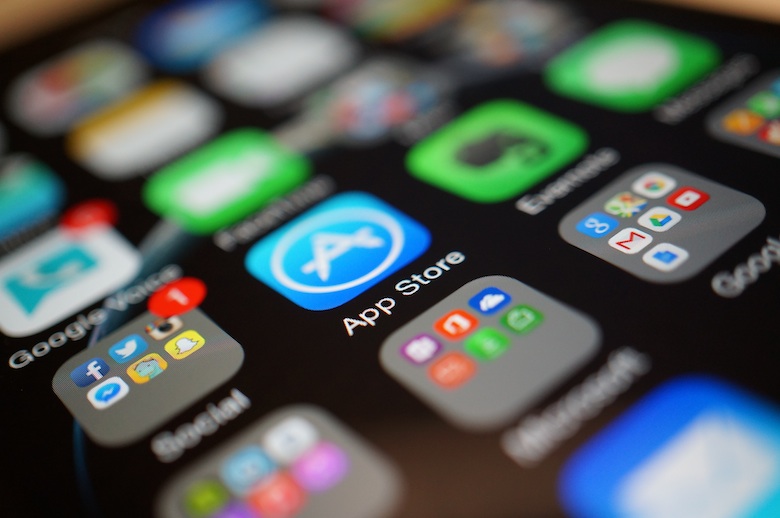 That larger display is a big part of the new iPhone’s story. It’s a retooled IPS LCD with an oddball resolution of 1334×750 and a pixel density of 326 pixels every inch. That’s a little low for a modern flagship; most smartphones these days stay above the 1080p threshold, and if you have exceptionally good eyes you may notice some fuzz. For our part: many of us are fresh from a year with the original Moto X, so we don’t mind. Colors are vibrant, blacks are about as deep as you can expect from a non-AMOLED panel, and outdoor visibility is good enough to get by, with a typical max brightness of about 500 nit. The screen also features a 100-percent sRGB gamut, which should please those who demand authentic color reproduction (though the panel’s whites are a touch too cool to our eyes).
That larger display is a big part of the new iPhone’s story. It’s a retooled IPS LCD with an oddball resolution of 1334×750 and a pixel density of 326 pixels every inch. That’s a little low for a modern flagship; most smartphones these days stay above the 1080p threshold, and if you have exceptionally good eyes you may notice some fuzz. For our part: many of us are fresh from a year with the original Moto X, so we don’t mind. Colors are vibrant, blacks are about as deep as you can expect from a non-AMOLED panel, and outdoor visibility is good enough to get by, with a typical max brightness of about 500 nit. The screen also features a 100-percent sRGB gamut, which should please those who demand authentic color reproduction (though the panel’s whites are a touch too cool to our eyes).
The panel’s real standout metric, natch, is its 4.7-inch diagonal size. That’s nothing to Android and Windows Phone users accustomed to displays of 5.5 inches and above, but it’s larger than any iPhone screen that’s come before. It’s a big enough shift that during our weeklong review period, we’ve been asked by several people whether our iPhone 6 is actually a 6 Plus. (FYI: it’s not even close.)
Software
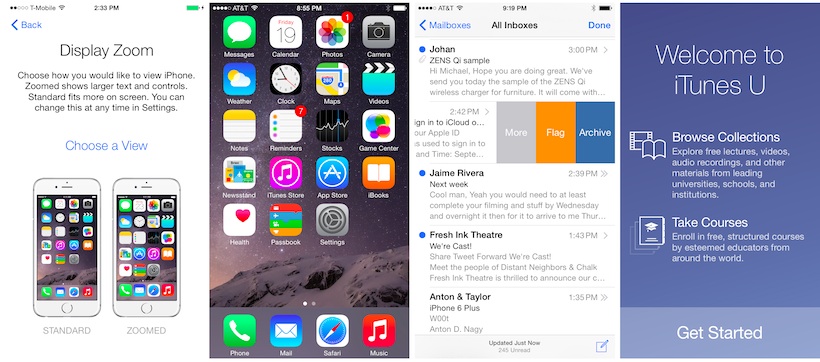
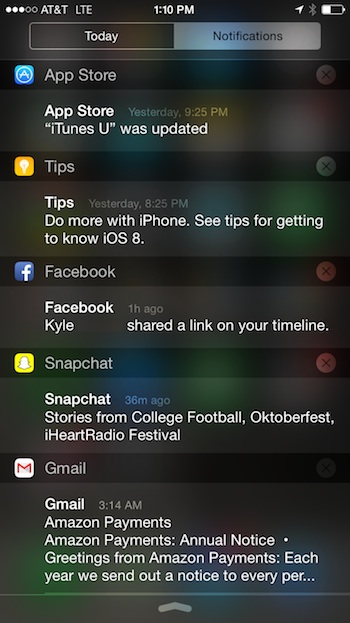 If you’re wondering how well Apple’s new software scales to that screen size, the answer is: wonderfully. We still chafe at the locked-down home screen and the generally restrictive software, but Apple gets so much else right that it’s really hard to hate iOS, even if you’re coming from Android or Windows Phone like this reviewer (daily drivers, for the record: Moto X / Lumia 1020).
If you’re wondering how well Apple’s new software scales to that screen size, the answer is: wonderfully. We still chafe at the locked-down home screen and the generally restrictive software, but Apple gets so much else right that it’s really hard to hate iOS, even if you’re coming from Android or Windows Phone like this reviewer (daily drivers, for the record: Moto X / Lumia 1020).
If iOS 7 was the iPhone upgrade that changed everything, iOS 8 is the maintenance release that smooths over the rough edges of reinvention. Your messages and alerts still reside in the Notification Center above, but now it’s been cleaned up and given a simpler layout; it also accommodates a condensed agenda view and useful bits of information like the daily forecast and any reminders you’ve set. Media controls, quick shortcuts and system toggles sit down in the Control Center below, accessible with a quick swipe of the thumb. Using that same thumb to swipe downward anywhere on the home screen brings you into Spotlight Search, essentially a direct port of Palm’s old Universal Search from webOS: type a query, and the iPhone searches the entire device, as well as Wikipedia and the broader web, to find a match. It’s blisteringly fast, great for quick lookup of an app or a contact, and it’s something every single manufacturer should offer – which we’ve been saying for yearsnow.
The iPhone’s single home button now accommodates more functions than ever, but despite this it still works very well. Apple’s TouchID is one of only two fingerprint-based security systems we actually enjoy using on a smartphone: putting your thumb to the home button unlocks the iPhone on the first try nearly 100% of the time, and using it to authorize App Store purchases is much more convenient than typing in a password. Double-pressing the home button summons the task switcher, which now includes frequent contacts – a cluttery but not unwelcome addition. Long-pressing the home button calls up Siri, as always; our time using Google Now and Cortana has rendered the world’s most famous virtual assistant a little quaint to our eyes, but she works well enough. Finally, a gentle double-tap activates “Reachability,” dropping down the entire UI to make the phone easier to use with one hand. Not all of us agree on the philosophy behind this solution to the problem of ever-growing smartphone screens, but it’s undeniably useful, and we’ll miss it when we switch away from iOS to review something else. Our life is a tough one.
Amid all this awesome, there’s some weak sauce as always. Apple isn’t immune to bugs, one of them being that Reachability doesn’t always work: several times, our iPhone 6 just sat there and stared at us when we double-tapped the home button. The ability to add custom keyboards is a long-overdue plus, but Apple’s selection is still anemic and full of half-finished or buggy downloads. Speaking of typing, the iPhone’s autocorrect and predictive-text implementation is way behind Android, Windows Phone, and even BlackBerry: it’s no wonder sites like DamnYouAutoCorrect are dominated by iOS screenshots. The Notification Center now supports widgets, but we’ve always found widgets most valuable when they’re glanceable; stuffing them out of the way in the shade up top seems to defeat the purpose. And in a smartphone landscape that’s more customizable than ever, it feels very limiting to use a phone with a fixed grid of icons as its primary homescreen. Apple’s software is better than ever before, but at its core, iOS is still iOS.
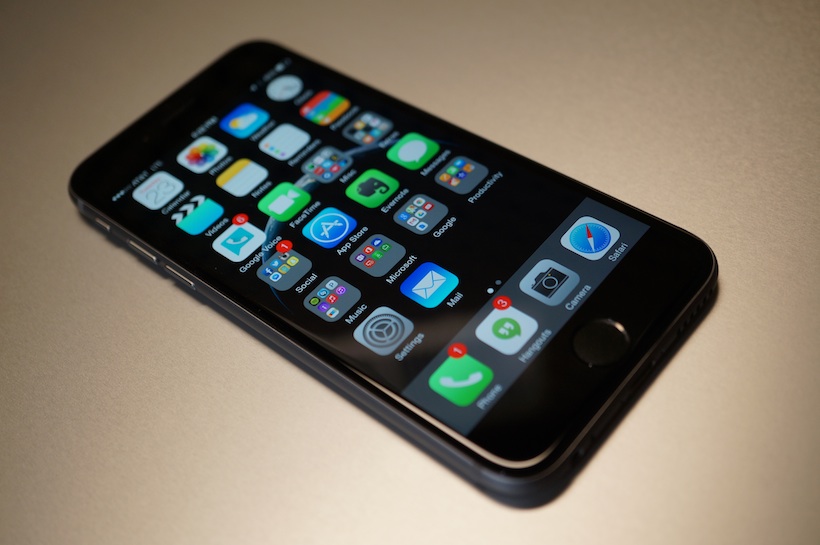
In many ways, that’s a good thing. Get past the same old hangups, and the day-to-day experience is wonderful thanks to the degree of polish Apple has brought to iOS over seven years of development. Nearly every common task you associate with a smartphone, the iPhone 6 handles with practiced competence. Third-party apps on the App Store are generally as good or better than you can find elsewhere, and Apple bundles many of its own excellent titles as well, from iMovie to Garage Band to its entire productivity suite. When you buy the iPhone 6, you buy a really nice software package from front to back.
Camera

Some corners of the iPhone still bear the shadow of the company’s skeuomorphichistory, and the camera viewfinder is one of them. It’s a nice-looking piece of software, but it trades intuitive functionality for cosmetics: the sliding mode adjuster is a frustratingly small touch target (you can swipe on the screen to change modes, but this isn’t self-evident and no tutorial exists to make this clear), and the new exposure control is a press-and-hold affair that’s awkward and also uncomfortably small. Despite the larger canvas now at its disposal, Apple is still designing for an undersized screen.
Get past that and you’ll probably have a good time shooting with the 8MP iSight camera, which features a five-element lens and an f/2.2 aperture (along with sapphire protection for its protruding lens, which should help it survive all the tabletops it’s going to be resting on). The iPhone 6 takes a novel approach to compensating for hand-trembles, with the software snapping four shots almost at once, then combining them for a clearer photo. On the down side, the colors it produces seem a bit muted, and something about the camera’s optics package makes it very susceptible to lens flare. The photos are also noisier than we like, with digital fuzz sometimes evident on close inspection, and HDR isn’t as effective as it is on other phones at bringing out highlights in dark areas. Dark shots themselves are acceptable, and not much more.
In camcorder mode, we see the same stability enhancement mentioned above. While it’s only digital stabilization (compared with the ostensibly superior optical stabilization of the iPhone 6 Plus), the results are very smooth. Auto-exposure and auto-focus are snappy too, with the iPhone able to cope with some pretty sudden swings and pans during filming. Colors are still a little watery if you’re used to the saturated output from other smartphones, but audio capture is quite good. And the 120fps/240fps slow-motion filming modes make for some very entertaining video, particularly if you use the onboard iMovie app to stitch them together.
Performance

 Powering the entire iPhone 6 experience is Apple’s new A8 system-on-a-chip. This is a 64-bit processor manufactured on a 20nm process, mated to a PowerVR GX6450 GPU and backed up by a single gig of RAM. That unique assortment of exceptional and sub-par figures is deceptive any way you look at it: to one kind of spec head, the 64-bit processor is droolworthy; to another, the 1GB of RAM is pitiful. To those not numerically inclined, this whole paragraph is meaningless.
Powering the entire iPhone 6 experience is Apple’s new A8 system-on-a-chip. This is a 64-bit processor manufactured on a 20nm process, mated to a PowerVR GX6450 GPU and backed up by a single gig of RAM. That unique assortment of exceptional and sub-par figures is deceptive any way you look at it: to one kind of spec head, the 64-bit processor is droolworthy; to another, the 1GB of RAM is pitiful. To those not numerically inclined, this whole paragraph is meaningless.
The upshot of the rundown above is this: the new iPhone is one of the smoothest smartphones we’ve tested. Our test notes say “nothing else comes close,” but that’s an exaggeration; lots of other phones do come close to this level of responsiveness. It’s just that none of them deliver it so consistently. From banal metrics like app launch speeds and gaming performance to tiny but crucial conveniences like the physical mute switch, the iPhone 6 performs like nothing else currently available.
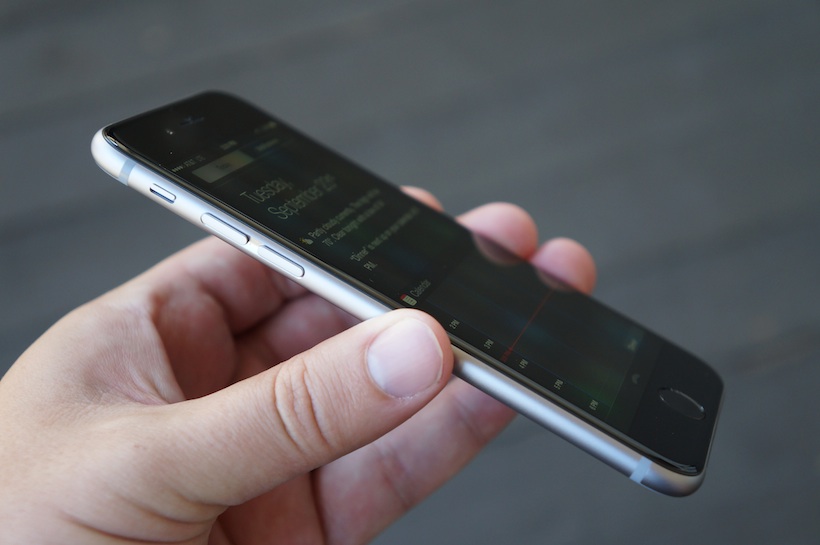
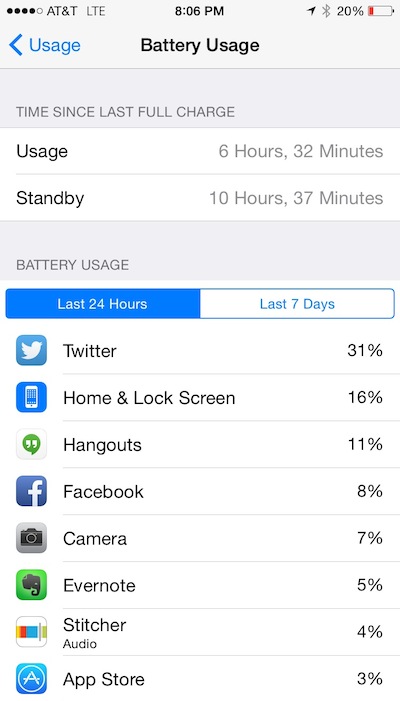 That carries over to audio performance too. You’d expect the company behind iTunes –and now Beats– to bring its A-Game in acoustics, and you’d be right: sound through the included earpods may not be Harman Kardon quality, but it’s perfectly fine to our ears. Also, the bottom-mounted speakerphone, while a tad on the tinny side, is much louder and clearer than we expected from such a small component.
That carries over to audio performance too. You’d expect the company behind iTunes –and now Beats– to bring its A-Game in acoustics, and you’d be right: sound through the included earpods may not be Harman Kardon quality, but it’s perfectly fine to our ears. Also, the bottom-mounted speakerphone, while a tad on the tinny side, is much louder and clearer than we expected from such a small component.
That loudspeaker is equally competent for voice calls, but switch over to the earpiece and things get a little muddier. Sound is plenty loud and clear on our end, with excellent sidetone – but callers said they heard lots of background noise from our side, particularly in even mild breeze. In our call comparison, the iPhone 6 was even bested by Samsung’s Galaxy S5, historically not a very strong contender in call quality.
Another spec that won’t impress the gearheads is battery capacity. At 1810 mAh, the iPhone’s lithium-ion power cell is substantially smaller than every other flagship phone on the market, and as on every iPhone, it’s also sealed within the casing so you can’t replace it on the fly. Fortunately, you don’t need to: with moderate to heavy usage we always got at least ten hours out of the iPhone, and we sometimes made it past 16 hours with power to spare. It’s tough to get more specific than that as iOS doesn’t allow testing screen-on time as Android does. As with most smartphones, you’ll want to consider a third-party charging case or battery pack if you’re a real road warrior, but if you generally go less than 12 hours between charges, you’ll probably be fine with the iPhone 6.
Pros
+ Outstanding build quality and feel in hand
+ iOS more adaptable and capable than ever before
+ Solid acoustic experience from earpods to loudspeaker
+ iPhone app/accessory ecosystem still the strongest of all platforms
Cons
- Aesthetics are a step backward
- iOS lacks needed customizability
- Lackluster call quality
Pricing and Availability
The iPhone 6 is available directly from Applein Silver, Gold, and Space Gray trims and capacities of 16GB ($649), 64GB ($749) or 128GB ($849). This being Apple, there’s no MicroSD expansion; the capacity you buy is what you’re stuck with for the duration of your time with the phone.
Due to preloaded software and the space taken by the OS, stated capacity is not actualcapacity. The 128GB model ships with 114GB free, while the 64GB model comes with 56GB available and the 16GB version makes do with a piddling 12.7 GB out of the box. As always, we recommend the higher-capacity models if you can afford them; depending on your carrier’s discount options, the iPhone 6 can be had for as little as $199 on a two-year contract.






































No comments:
Post a Comment